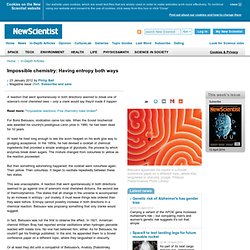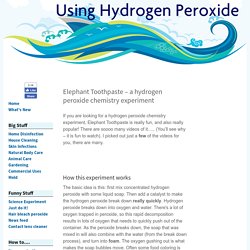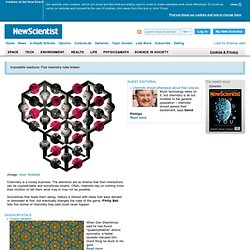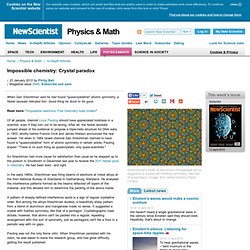

Radiation dosages. Build an Atom. Acid and Alkaline difference. Impossible chemistry: Having entropy both ways - 23 January 2012. A reaction that went spontaneously in both directions seemed to break one of science's most cherished laws – only a crank would say they'd made it happen Read more: "Impossible reactions: Five chemistry rules broken" For Boris Belousov, vindication came too late.

When the Soviet biochemist was awarded his country's prestigious Lenin prize in 1980, he had been dead for 10 years. Liquid Crystals. Lists of Nobel Prizes and Laureates Liquid Crystals Play the Crystallite Game Play the Mainstream Game About the game A liquid crystal is a substance that flows like a liquid but maintains some of the ordered structure characteristic of crystals.

Scientists Invent Particles That Will Let You Live Without Breathing. Lead (Pb) 03/19 > BE Espagne 113 > A la recherche d'une meilleure productivité des énergies renouvelables. Acids And Bases. World's Scariest Drug (Documentary Exclusive) 05/09 > BE Belgique 61 > Recherches à l'ULB : un cadre théorique pour comprendre les effets de la discontinuité moléculaire. BiologieRecherches à l'ULB : un cadre théorique pour comprendre les effets de la discontinuité moléculaire La discontinuité moléculaire est apparente dans des systèmes chimiques de petit volume et conduit à des cinétiques stochastiques.

L'article paru dans Nature Communications expose le travail de Nélido González-Segredo, et de ses collaborateurs de l'Institut d'Informatique Théorique de l'ETH de Zurich et de la Faculté des Sciences Biologiques de l'Université d'Edimbourg. Ils y présentent un cadre théorique pour comprendre les effets de la discontinuité sur l'état stationnaire d'un réseau de réactions monostables. Ils examinent différentes solutions de la même concentration dans des compartiments de différents volumes. Les équations cinétiques classiques ignorent la discontinuité et prévoient les mêmes concentrations moyennes dans tous les compartiments.
Simple reaction makes the building blocks of a nucleic acid. Origin-of-life researchers face a deceptively straightforward question: how did simple chemicals produce complex biochemistry?

The complexity of this starts to come in when you consider the many complex biomolecules that would have been useful or essential to the first biochemical reactions. And it gets worse when you consider that there are lots of simple organic chemicals that plausibly could have been present on the early Earth. Figuring out which reactions to even start looking at can be a real challenge. The extent of that challenge was highlighted a few years back, when a Cambridge lab suggested most earlier researchers had gone down a dead end. Previously, researchers tried to build up a sugar and a nucleic acid base separately, and then link to them to form precursors of DNA and RNA. In a new paper, the same lab tackles forming the simple, two- and three-atom sugars used in their earlier work (glycolaldehyde and glyceraldehyde).
Linking simple chemistry to something like life. Origin of life researchers have made impressive progress in recent years, showing that simple chemicals can combine to make nucleotides, the building blocks of DNA and RNA.

Given the right conditions, these nucleotides can combine into ever-longer stretches of RNA. A lot of work has demonstrated that RNAs can perform all sorts of interesting chemistry, specifically binding other molecules and catalyzing reactions. So the case for life getting its start in an RNA world has gotten very strong in the past decade, but the difference between a collection of interesting RNAs and anything like a primitive cell—surrounded by membranes, filled with both RNA and proteins, and running a simple metabolism—remains a very wide chasm. Or so it seems. A set of papers that came out in the past several days suggest that the chasm might not be as large as we'd tend to think. Ironing out metabolism DNA and RNA tend to have nothing to do with iron, interacting with magnesium instead.
Proteins build membranes. Elephant Toothpaste , a hydrogen peroxide chemistry experiment. If you are looking for a hydrogen peroxide chemistry experiment, Elephant Toothpaste is really fun, and also really popular!

There are soooo many videos of it….. (You’ll see why – it is fun to watch). I picked out just a few of the videos for you, there are many. How this experiment works The basic idea is this: first mix concentrated hydrogen peroxide with some liquid soap. Elephant toothpaste demo #1 (Catalyst: potassium iodide) This first video is a great introduction to Elephant Toothpaste – all of the ingredients are clearly labeled with captions. Elephant toothpaste demo #2 (no soap) (Catalyst: manganese dioxide) This one is also a great introduction. Elephant toothpaste #3 – classic (Catalyst: not stated) This one is more a “classic“. The basic idea of elephant toothpaste: make hydrogen peroxide decompose quickly In many situations, hydrogen peroxide is quite stable, but, there are ways to make it break down.
Think of it this way: you start with peroxide and liquid soap. Boy discovers microbe that eats plastic. It's not your average science fair when the 16-year-old winner manages to solve a global waste crisis. But such was the case at last May's Canada-Wide Science Fair in Ottawa, Ontario, where Daniel Burd, a high school student at Waterloo Collegiate Institute, presented his research on microorganisms that can rapidly biodegrade plastic. Daniel had a thought it seems even the most esteemed PhDs hadn't considered. Plastic, one of the most indestructible of manufactured materials, does in fact eventually decompose. It takes 1,000 years but decompose it does, which means there must be microorganisms out there to do the decomposing. Speeding up a Reaction. Chemistry News, Videos, Reviews and Gossip - io9. Interesting — when I was in the Army, it was called CBR (chemical, biological, radioactive).

I wonder why they changed the order and the initials? Pressure from Jay Leno? NBC was for Nuclear, Biological, Radiological. I think it might have been for memory's sake, which might have something to do with the tv studio indeed - but maybe just for giggles. The military does not always make sense. Chemical element games - periodic table info. Impossible reactions: Five chemistry rules broken. Cookies on the New Scientist website close Our website uses cookies, which are small text files that are widely used in order to make websites work more effectively.

Impossible chemistry: Crystal paradox - physics-math - 23 January 2012. When Dan Shechtman said he had found "quasicrystalline" atomic symmetry, a Nobel laureate ridiculed him.

Good thing he stuck to his guns Read more: "Impossible reactions: Five chemistry rules broken"